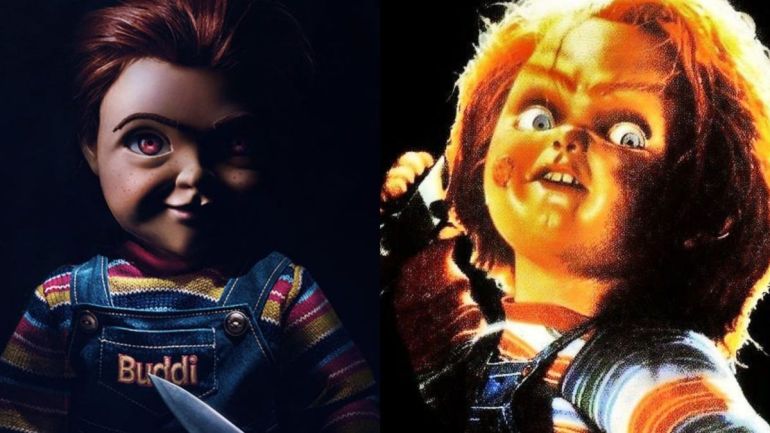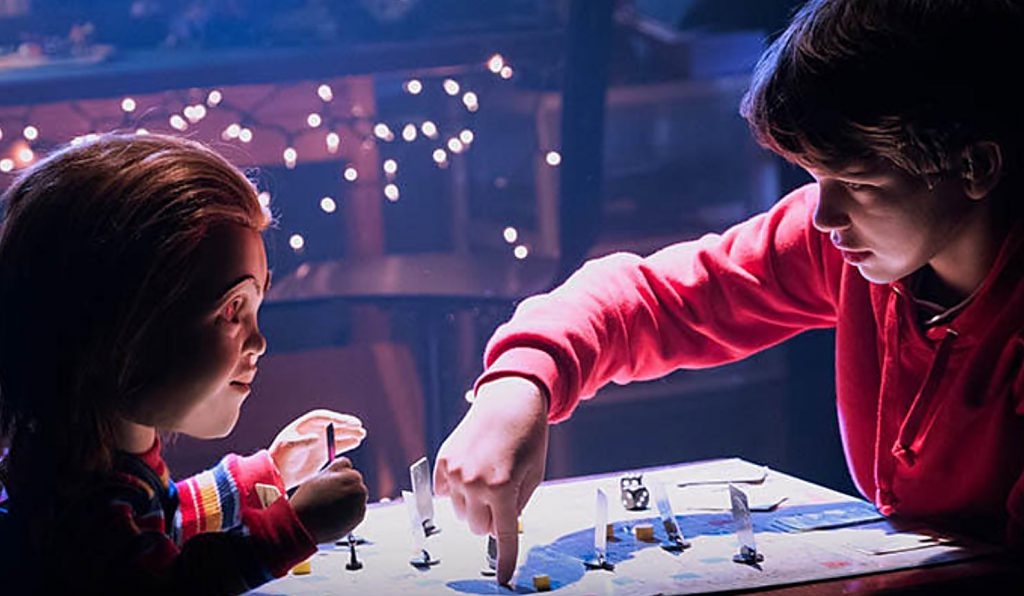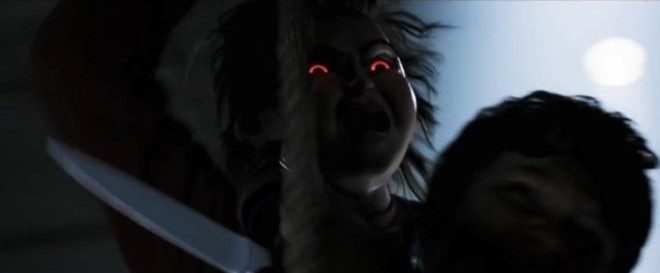The Child’s Play film franchise continues to sustain a fan base of horror fanatics since the release of Child’s Play (1988) and Child’s Play 2 (1990), making way for Child’s Play 3 (1991), Bride of Chucky (1998), Seed of Chucky (2004) and more. Though each film since the original has been advertised as a cash-grab, fans enjoy watching a creepy doll revel in murdering human beings with every sequel. Child’s Play (2019), directed by Lars Klevberg, is a contemporary re-imagining of the original 1988 classic. The film follows a single mother, Karen (Aubrey Plaza), and an adolescent boy, Andy (Gabriel Bateman) who yearns for emotional support and social stability from his new ‘Buddi’ doll, Chucky (voiced by Mark Hamill). When Chucky is discovered to be sinister and uncontrollable by flawed programming, he kills people using various technological tools.

Child’s Play Chucky in 2019 (left) versus Chucky in 1988 (right).
Compared to the original Child’s Play, I find this remake to be entertaining and a real treat for any fan of the franchise. Right off the bat, the film has talents from Mark Hamill (voices the Joker in Batman: The Animated series (1992-94) and plays Luke Skywalker in the Star Wars franchise) and recent star Aubrey Plaza (April Ludgate in the TV series Parks and Recreation (2009-15) and Julie Powers in Scott Pilgrim vs the World (2010)). The film has interesting, dynamic character development. The theme about too much human reliance on future technological advancements is mind-blowing when thinking of our own high reliance on technology to meet our needs. The sound production is stellar alongside the effective use of both CG effects and puppetry to present Chucky’s functionality and human-like behavior.

Andy (right) relies on Chucky as a means of developing social skills that others cannot.
Character development is the strongest component of the narrative. Karen is a single parent – she works constantly and has bad luck finding boyfriends who are willing to care for her, as well as her son. She fails to be a role-model for her son; she’s mostly absent from his life except for when she needs to feed him and make sure he is home. This relationship dynamic between Karen and Andy changes as the narrative goes on. Andy struggles to make friends because he is afraid to interact with new people and is bullied for using a hearing aid. When trying to confide in Karen and other adults, he is seen as just a kid with a wild imagination and blooming hormones. He connects with Chucky the most because he realizes they are both “different;” Chucky has faulty programming, glitches a lot, and Andy is hearing-impaired. When he receives Chucky, the doll initially fills that social-acceptance gap. Chucky as an uncanny, human-like doll is exactly what drives the narrative: he is able to make decisions for himself, defy human control, talk and walk on his own, and express emotions through tone of voice and facial expressions.
The narrative is built on one main theme: the fear that human technology will become so advanced that it becomes uncontrollable. This theme makes the film entertaining; the electronic ‘Buddi’ dolls are controlled via smartphone and respond to voice commands while also taking on multiple roles such as caregiver, playmate and educator. Chucky is the one exception in that he can’t be controlled. He uses different pieces of technology freely to carry out his killings: he takes control of a car from miles away, he controls other Buddi dolls and drones to attack people locked in a store, he uses an electric tiller to destroy a man’s head, and even gains access to Andy’s hearing aid to manipulate him. With the access to technology also comes the separation of the younger generation from the older generation; the young kids in the film are successful in evading death by understanding how Chucky functions while the older adults, who don’t use new technology or don’t believe the kids, end up dead.
The diegetic and non-diegetic sound accompanied by the practical and CG effects add mood and a touch of realistic satisfaction to the film as a whole. The score is filled with twinkles and innocent, toy-like chimes in the first half of the film. The score eventually gets drowned out by low, sudden booms that sugar-coat the creepy, suspenseful narrative at the end when Chucky becomes violent. Chucky’s physical, robotic motions are amplified by mechanical sounds when he creates facial expressions, walks and moves his arms around. The interchanges between Chucky being presented as a practical puppet and a CG character are subtle; the CG is noticeable and most effective during the murders and the end scene, otherwise having the built puppet better enhanced the creepy factor and making the doll look more humanistic.

The film employs CG effects for Chucky when working with the puppet is difficult.
The remake was impressive. The characters themselves and their social dynamics were fun. The anxieties around the reliance on technological advancements made it more entertaining. The score and practical effects/CG definitely added to the overall suspense and uncomfortably-creepy mood. For being a horror film, there wasn’t a bunch of jump scares but this is not a film for those who are squeamish at the sight of blood and gore (hence the ‘R’ rating). For fans of the franchise, I recommend seeing this film at least once. Child’s Play (2019) is the horror film to see this Halloween.
![]()
–Child’s Play was released on Digital HD September 10th and on DVD and Blu-ray September 24th.


Recent Comments